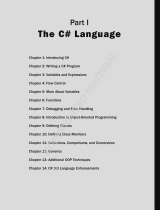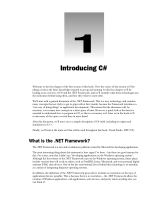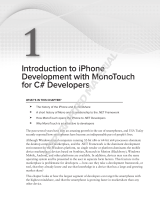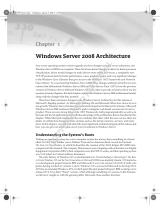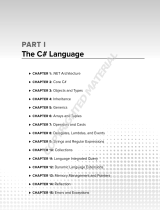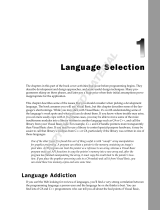Page is loading ...

1
Introducing C#
Welcome to the first chapter of the first section of this book. Over the course of this section, you
look at the basic knowledge required to get up and running with C#. In this first chapter, you get
an overview of C# and the .NET Framework, and you consider what these technologies are, the
motivation for using them, and how they relate to each other.
You start with a general discussion of the .NET Framework. This is still a new technology and con-
tains many concepts that are tricky to come to grips with at first (mainly because the Framework
introduces a new way of doing things to application development). This means that the discussion
will, by necessity, cover many new concepts in a short space of time. However, a quick look at the
basics is essential to understand how to program in C#, so this is a necessary evil. Later in the
book you will revisit many of the topics covered here in more detail.
After this general discussion, you move on to a simple description of C# itself, including its origins
and similarities to C++. Finally, you look at the primary tool used throughout this book: Visual
Studio 2005 (VS).
In this chapter, you learn:
❑ What C# and the .NET Framework are
❑ How the .NET Framework works and what makes it special
❑ What you can do with C#
❑ What Visual Studio 2005 is and how it fits in with this book
What Is the .NET Framework?
The .NET Framework is a new and revolutionary platform created by Microsoft for developing
applications.
05_578472 ch01.qxd 9/22/05 10:54 PM Page 3
COPYRIGHTED MATERIAL

The most interesting thing about this statement is how vague I’ve been— but there are good reasons
for this. For a start, note that I didn’t say “developing applications on the Windows operating system.”
Although the Microsoft release of the .NET Framework runs on the Windows operating system, it is fast
becoming possible to find alternative versions that will work on others. One example of this is Mono, an
open source version of the .NET Framework (including a C# compiler) that will run on several operating
systems, including various flavors of Linux and Mac OS. More such projects are in the pipeline and may
be available by the time you read this. In addition, you can use the Microsoft .NET Compact Framework
(essentially a subset of the full .NET Framework) on personal digital assistant (PDA) class devices and
even some smartphones. One of the key motivational forces behind the .NET Framework is its intended
use as a means of integrating disparate operating systems.
In addition, the definition of the .NET Framework given above includes no restriction on the type of
applications that are possible. This is because there is no restriction— the .NET Framework allows the
creation of Windows applications, Web applications, Web services, and pretty much anything else you
can think of.
The .NET Framework has been designed so that it can be used from any language. This includes the sub-
ject of this book, C#, as well as C++, Visual Basic, JScript, and even older languages such as COBOL. For
this to work, .NET-specific versions of these languages have also appeared, and more are being released
all the time. Not only do all of these have access to the .NET Framework, but they can also communicate
with each other. It is perfectly possible for C# developers to make use of code written by Visual Basic
programmers, and vice versa.
All of this provides a hitherto unthinkable level of versatility and is part of what makes using the .NET
Framework such an attractive prospect.
What’s in the .NET Framework?
The .NET Framework consists primarily of a gigantic library of code that you use from your client lan-
guages (such as C#) using object-oriented programming (OOP) techniques. This library is categorized
into different modules — you use portions of it depending on the results you want to achieve. For exam-
ple, one module contains the building blocks for Windows applications, another for network program-
ming, and another for Web development. Some modules are divided into more specific submodules,
such as a module for building Web services within the module for Web development.
The intention here is for different operating systems to support some or all of these modules, depending
on their characteristics. A PDA, for example, would include support for all the core .NET functionality,
but is unlikely to require some of the more esoteric modules.
Part of the .NET Framework library defines some basic types. A type is a representation of data, and
specifying some of the most fundamental of these (such as “a 32-bit signed integer”) facilitates interoper-
ability between languages using the .NET Framework. This is called the Common Type System (CTS).
As well as supplying this library, the Framework also includes the .NET Common Language Runtime (CLR),
which is responsible for maintaining the execution of all applications developed using the .NET library.
4
Chapter 1
05_578472 ch01.qxd 9/22/05 10:54 PM Page 4

How Do I Write Applications Using the .NET Framework?
Writing an application using the .NET Framework means writing code (using any of the languages that
support the Framework) using the .NET code library. In this book you use VS for your development —
VS is a powerful, integrated development environment that supports C# (as well as managed and
unmanaged C++, Visual Basic, and some others). The advantage of this environment is the ease with
which .NET features can be integrated into your code. The code that you will create will be entirely C#
but will use the .NET Framework throughout, and you make use of the additional tools in VS where
necessary.
In order for C# code to execute, it must be converted into a language that the target operating system
understands, known as native code. This conversion is called compiling code, an act that is performed by
a compiler. Under the .NET Framework, however, this is a two-stage process.
MSIL and JIT
When you compile code that uses the .NET Framework library, you don’t immediately create operating
system–specific native code. Instead, you compile your code into Microsoft Intermediate Language (MSIL)
code. This code isn’t specific to any operating system and isn’t specific to C#. Other .NET languages —
for example, Visual Basic .NET— also compile to this language as a first stage. This compilation step is
carried out by VS when you use it to develop C# applications.
Obviously, to execute an application more work is necessary. This is the job of a Just-in-Time (JIT) com-
piler, which compiles MSIL into native code that is specific to the OS and machine architecture being
targeted. Only at this point can the OS execute the application. The just-in-time part of the name here
reflects the fact that MSIL code is only compiled as and when it is needed.
In the past, it was often necessary to compile your code into several applications, each of which targeted
a specific operating system and CPU architecture. Often, this was a form of optimization (to get code to
run faster on an AMD chipset, for example), but at times it was critical (for applications to work in both
Win9x and WinNT/2000 environments, for example). This is now unnecessary, because JIT compilers (as
their name suggests) use MSIL code, which is independent of the machine, operating system, and CPU.
Several JIT compilers exist, each targeting a different architecture, and the appropriate one will be used
to create the native code required.
The beauty of all this is that it requires a lot less work on your part — in fact, you can just forget about
system-dependent details and concentrate on the more interesting functionality of your code.
Assemblies
When you compile an application, the MSIL code created is stored in an assembly. Assemblies include
both executable application files that you can run directly from Windows without the need for any other
programs (these have a
.exe file extension), and libraries for use by other applications (which have a
.dll extension).
As well as containing MSIL, assemblies also contain meta information (that is, information about the
information contained in the assembly, also known as metadata) and optional resources (additional data
used by the MSIL, such as sound files and pictures). The meta information allows assemblies to be fully
5
Introducing C#
05_578472 ch01.qxd 9/22/05 10:54 PM Page 5

self-descriptive. You need no other information to use an assembly, meaning that you avoid situations
such as failing to add required data to the system registry and so on, which was often a problem when
developing with other platforms.
This means that deploying applications is often as simple as copying the files into a directory on a remote
computer. Since no additional information is required on the target systems, you can just run an executable
file from this directory and (assuming the .NET CLR is installed) away you go.
Of course, you won’t necessarily want to include everything required to run an application in one place.
You might write some code that performs tasks required by multiple applications. In situations like this, it
is often useful to place this reusable code in a place accessible to all applications. In the .NET Framework,
this is the Global Assembly Cache (GAC). Placing code in this cache is simple — you just place the assembly
containing the code in the directory containing this cache.
Managed Code
The role of the CLR doesn’t end once you have compiled your code to MSIL, and a JIT compiler has
compiled this to native code. Code written using the .NET Framework is managed when it is executed
(this stage is usually referred to as being at runtime). This means that the CLR looks after your applica-
tions by managing memory, handling security, allowing cross-language debugging, and so on. By con-
trast, applications that do not run under the control of the CLR are said to be unmanaged and certain
languages such as C++ can be used to write such applications that, for example, access low-level func-
tions of the operating system. However, in C# you can write only code that runs in a managed environ-
ment. You will make use of the managed features of the CLR and allow .NET itself to handle any
interaction with the operating system.
Garbage Collection
One of the most important features of managed code is the concept of garbage collection. This is the .NET
method of making sure that the memory used by an application is freed up completely when the appli-
cation is no longer in use. Prior to .NET this has mostly been the responsibility of programmers, and a
few simple errors in code could result in large blocks of memory mysteriously disappearing as a result
of being allocated to the wrong place in memory. This usually meant a progressive slowdown of your
computer followed by a system crash.
.NET garbage collection works by inspecting the memory of your computer every so often and removing
anything from it that is no longer needed. There is no set timeframe for this; it might happen thousands of
times a second, once every few seconds, or whenever, but you can rest assured that it will happen.
There are some implications for programmers here. Since this work is done for you at an unpredictable
time applications have to be designed with this in mind. Code that requires a lot of memory to run
should tidy itself up rather than waiting for garbage collection to happen, but this isn’t anything like as
tricky as it sounds.
Fitting It Together
Before moving on, I’ll summarize the steps required to create a .NET application as discussed previously:
1. Application code is written using a .NET-compatible language such as C#, as shown in Figure 1-1.
6
Chapter 1
05_578472 ch01.qxd 9/22/05 10:54 PM Page 6

Figure 1-1
2. This code is compiled into MSIL, which is stored in an assembly, as shown in Figure 1-2.
Figure 1-2
3. When this code is executed (either in its own right if it is an executable or when it is used
from other code) it must first be compiled into native code using a JIT compiler, as shown in
Figure 1-3.
Figure 1-3
4. The native code is executed in the context of the managed CLR, along with any other running
applications or processes, as shown in Figure 1-4.
Figure 1-4
Native Code
.NET CLR
System Runtime
Native Code Native Code
Assembly
Native Code
JIT Compilation
C#application
code
AssemblyCompilation
C#code
7
Introducing C#
05_578472 ch01.qxd 9/22/05 10:54 PM Page 7

Linking
There is one additional point to note concerning the preceding process. The C# code that compiles into
MSIL in step 2 needn’t be contained in a single file. It is possible to split application code across multiple
source code files, which are then compiled together into a single assembly. This process is known as link-
ing and is extremely useful. The reason for this is that it is far easier to work with several smaller files
than one enormous one. You can separate out logically related code into an individual file, so that it can
be worked on independently and then practically forgotten about when completed. This also makes it
much easier to locate specific pieces of code when you need them and enables teams of developers to
divide up the programming burden into manageable chunks, where individuals can “check out” pieces
of code to work on without risking damage to otherwise satisfactory sections or sections that other peo-
ple are working on.
What Is C#?
C#, as mentioned earlier, is one of the languages that can be used to create applications that will run in
the .NET CLR. It is an evolution of the C and C++ languages and has been created by Microsoft specifi-
cally to work with the .NET platform. Because it is a recent development, the C# language has been
designed with hindsight, taking into account many of the best features from other languages, while
clearing up their problems.
Developing applications using C# is simpler than using C++, because the language syntax is simpler.
However, C# is a powerful language, and there is little you might want to do in C++ that you can’t do
in C#. Having said that, those features of C# that parallel the more advanced features of C++, such as
directly accessing and manipulating system memory, can only be carried out using code marked as
unsafe. This advanced programmatic technique is potentially dangerous (hence its name), because it is
possible to overwrite system-critical blocks of memory with potentially catastrophic results. For this rea-
son, and others, this book will not cover this topic.
At times, C# code is slightly more verbose than C++. This is a consequence of C# being a type-safe lan-
guage (unlike C++). In layperson’s terms, this means that once some data has been assigned to a type, it
cannot subsequently transform itself into another unrelated type. Consequently, there are strict rules that
must be adhered to when converting between types, which means that you will often need to write more
code to carry out the same task in C# than you might write in C++, but you get the benefits that code is
more robust and debugging is simpler — .NET can always track what type a piece of data is at any time.
In C#, you therefore may not be able to do things such as “take the region of memory 4 bytes into this
data and 10 bytes long and interpret it as X,” but that’s not necessarily a bad thing.
C# is just one of the languages available for .NET development, but in my opinion it is certainly the best.
It has the advantage of being the only language designed from the ground up for the .NET Framework
and may be the principal language used in versions of .NET that are ported to other operating systems.
To keep languages such as the .NET version of Visual Basic as similar as possible to their predecessors
yet compliant with the CLR, certain features of the .NET code library are not fully supported. By con-
trast, C# is able to make use of every feature that the .NET Framework code library has to offer. The lat-
est version of .NET includes several improvements to the C# language, partly in response to requests
from developers, making it even more powerful.
8
Chapter 1
05_578472 ch01.qxd 9/22/05 10:54 PM Page 8

What Kind of Applications Can I Write with C#?
The .NET Framework has no restrictions on the types of applications that are possible, as discussed ear-
lier. C# uses the Framework and so also has no restrictions on possible applications. However, here are a
few of the more common application types:
❑ Windows Applications: These are applications, such as Microsoft Office, which have a familiar
Windows look and feel about them. This is made simple by using the Windows Forms module
of the .NET Framework, which is a library of controls (such as buttons, toolbars, menus, and so
on) that you can use to build a Windows user interface (UI).
❑ Web Applications: These are Web pages such as might be viewed through any Web browser.
The .NET Framework includes a powerful system of generating Web content dynamically,
allowing personalization, security, and much more. This system is called ASP.NET (Active
Server Pages .NET), and you can use C# to create ASP.NET applications using Web Forms.
❑ Web Services: These are a new and exciting way of creating versatile distributed applications.
Using Web services you can exchange virtually any data over the Internet, using the same simple
syntax regardless of the language used to create a Web service or the system that it resides on.
Any of these types may also require some form of database access, which can be achieved using the
ADO.NET (Active Data Objects .NET) section of the .NET Framework. Many other resources can be
drawn on, such as tools for creating networking components, outputting graphics, performing complex
mathematical tasks, and so on.
C# in This Book
The first section of this book deals with the syntax and usage of the C# language without too much empha-
sis on the .NET Framework. This is necessary, because you won’t be able to use the .NET Framework at
all without a firm grounding in C# programming. You start off even simpler, in fact, and leave the more
involved topic of object-oriented programming (OOP) until you’ve covered the basics. These will be taught
from first principles, assuming no programming knowledge at all.
Once you have done this, you will be ready to move on to developing the types of application listed in the
last section. Section two of this book will look at Windows Forms programming, Section three will look at
Web application and Web service programming, Section four will examine data access (for database, file
system and XML data), and Section five covers some other .NET topics of interest (such as more about
assemblies and graphics programming).
Visual Studio 2005
In this book, you use Visual Studio 2005 (VS) for all of your C# development, from simple command-line
applications to the more complex project types considered. VS isn’t essential for developing C# applica-
tions, but it makes things much easier for you. You can (if you wish to) manipulate C# source code files
in a basic text editor, such as the ubiquitous Notepad application, and compile code into assemblies
using the command-line compiler that is part of the .NET Framework. However, why do this when you
have the full power of VS to help you?
9
Introducing C#
05_578472 ch01.qxd 9/22/05 10:54 PM Page 9

The following is a quick list of some of the features of VS that make it an appealing choice for .NET
development:
❑ VS automates the steps required to compile source code but at the same time gives you com-
plete control over any options used should you wish to override them.
❑ The VS text editor is tailored to the languages VS supports (including C#) so that it can intelli-
gently detect errors and suggest code where appropriate as you are typing.
❑ VS includes designers for Windows Forms and Web Forms applications, allowing simple drag-
and-drop design of UI elements.
❑ Many of the types of project possible in C# may be created with “boilerplate” code already in
place. Instead of starting from scratch, you will often find that various code files are started off
for you, reducing the amount of time spent getting started on a project. This is especially true of
the new “Starter Kit” project type, which allows you to develop from a fully functional applica-
tion base. Some starter kits are included with the VS installation, and you can find plenty more
online to play with.
❑ VS includes several wizards that automate common tasks, many of which can add appropriate
code to existing files without you having to worry about (or even, in some cases, remember) the
correct syntax.
❑ VS contains many powerful tools for visualizing and navigating through elements of your
projects, whether they are C# source code files or other resources such as bitmap images or
sound files.
❑ As well as simply writing applications in VS, it is possible to create deployment projects, mak-
ing it easy to supply code to clients and for them to install it without much trouble.
❑ VS enables you to use advanced debugging techniques when developing projects, such as the
ability to step through code one instruction at a time while keeping an eye on the state of your
application.
There is much more than this, but hopefully you have the idea!
Visual Studio 2005 Express Products
In addition to Visual Studio 2005, Microsoft also supplies several simpler development tools known as
Visual Studio 2005 Express Products. These are currently (at the time of this writing) in beta versions,
but are freely available at
http://lab.msdn.microsoft.com/express.
Two of these products, Visual C# 2005 Express and Visual Web Developer 2005 Express, together allow
you to create almost any C# application you’d care to mention. They both function as cut-down versions
of VS and retain the same look and feel. While they offer many of the same features as VS, there are
some notable feature absences, although not so many that they would prevent you from using them to
work through this book.
VS Solutions
When you use VS to develop applications, you do so by creating solutions. A solution, in VS terms, is
more than just an application. Solutions contain projects, which might be “Windows Forms projects,”
10
Chapter 1
05_578472 ch01.qxd 9/22/05 10:54 PM Page 10

“Web Form projects,” and so on. However, solutions can contain multiple projects, so that you can group
together related code in one place, even if it will eventually compile to multiple assemblies in various
places on your hard disk.
This is very useful, because it allows you to work on shared code (which might be placed in the GAC) at
the same time as applications that use this code. Debugging code is a lot easier when only one develop-
ment environment is used, because you can step through instructions in multiple code modules.
Summary
In this chapter, you looked at the .NET Framework in general terms and discovered how it makes it easy
for you to create powerful and versatile applications. You saw what is necessary to turn code in languages
such as C# into working applications and what benefits you gain from using managed code running in
the .NET Common Language Runtime.
You also saw what C# actually is and how it relates to the .NET Framework, and you were introduced to
the tool that you’ll use for C# development — Visual Studio .NET.
In this chapter, you learned:
❑ What the .NET Framework is, why it was created, and what makes it such an attractive environ-
ment to program in
❑ What C# is and what makes it an idea tool to program in the .NET Framework
❑ What you need to develop .NET applications effectively, namely a development environment
such as Visual Studio 2005
In the next chapter, you get some C# code running using VS, which will give you enough knowledge to
sit back and concentrate on the C# language itself, rather than worrying too much about how VS works.
11
Introducing C#
05_578472 ch01.qxd 9/22/05 10:54 PM Page 11

05_578472 ch01.qxd 9/22/05 10:54 PM Page 12
/
